|
I'm still
wandering around in the forest waiting for most of the mushrooms to grow.
There are
none at the moment even though we are supposed to be at the peak of the season,
but the rains we had by the end of the summer were not enough and the forest
was still far too dry for them to grow.
Hopefully
they won't be long now. Cold winds from the north (Tramuntana) and humid winds
from the Northeast (Gargal. "Tramuntana i Gargal, fred, pluja i temporal")
brought a big storm to the Islands that was reactivated and gained more power
as soon as it was right above the sea because of the very high Mediterranean
temperatures for this time of the year.
This tempest
was the biggest in the last decade for us here in Ibiza (in Mallorca they say
that it was the biggest they have had for the last thirty years or more).
The storm
affected all the western Mediterranean from the northern-African countries,
with quite a few fatal victims in Morocco, Argelia and Tunisia, through the
East of Spain, the Balearic Islands and the Catalan Country with at least six
fatal victims, three or four of them in Mallorca, none in Ibiza-Formentera.
But winds
blasting at over a hundred kilometres per hour have devastated our littoral
with damage estimated at more then 4,800,000 Euros (800,000,000 Pesetas) just
for the two Islands and there are still a few boats to be rescued from the rocks,
if this is possible. The damage and ecological impact inland was also awesome,
with hundreds of trees uprooted or broken, most of the oranges and lemons on
the floor, plastic greenhouses destroyed, etc.
We were
not in the heart of the storm, so, it could have been much worse. For instance
the rain and hail that did a lot of damage in other sites was beautiful for
us here. We have had plenty of good and gentle rain, not too much at a time,
in the last week, well over one hundred litres per square meter. This is about
fifty per cent of what we had for a full year in 1997-98-99 and so this is the
good news for us about this storm. The strong and devastating winds have also
stopped with the end of the rains. Welcome to this very much-needed water!
So even
the mushroom season is quite advanced and we have already lost half of it. We
still can trust on finding a few within the next month, too at the most, depending
on the weather. Let's hope the Sun keeps shining as now, temperatures don't
drop too much and strong Northwest dry winds (Mistral) don't rise up.
The firsts
edible mushrooms to appear here in Ibiza, will be "Russula delica"
- there's plenty of them and practically nobody collects them because very few
know about how good they taste if done properly.
"Amanita
ovoidea" - "Farinera" as a local name, one of the few of this
family on the Island, the biggest of the "Agaric" type of mushroom
that grows in our fields can reach over twenty centimetres - the diameter of
its hat - thirty centimetres high, all white. It is edible and good when young
and eaten in some parts of Spain, though I have never tried it, I don't trust
the amanitas (there is also here a very similar type, "Amanita ovoidea,
proxima dumÚe" that is classed as toxic by other books) and I find something
repulsive in its smell).
"Cantharellus
cibarius" (Chanterelle) only a few of them grow in parts of the forest
where "Cuscoi," a small type of autochthonous wild evergreen oak,
grows too, most probably in symbiosis with its roots. This is very aromatic
(apricot-like) and tastes as mushrooms are known and appreciated in most of
Europe, unknown by the great majority of people from the Island.
"Boletus
bourdieri" and similar species, also plentiful, but only to be eaten while
they are very young, also ignored by most of us,
"Psalliota
camprestris" "Psalliota edulis" (Field mushroom), two very similar
species with the "classic" cultivated mushroom that we buy at the
shop, "Champignon de Paris" or "Psalliota bispora", all
excellent to eat.
"Psalliota"
or "Agaricus" as they are called at present times. This is a type
of mushroom that can be confused with the deadly poisonous white "Amanitas"
(not in Ibiza, there are none of them here) because of its colour, size and
the ring of the stem. But the gills are first pink, then turning chocolate brown
when they start releasing the spores, to almost black with time (it is better
not to eat them then). They never have pure white gills and are always without
a "Volva", a kind of bag or cup around the base of the stem, as the
"amanitas" have. Another way to recognise the "Field mushroom"
is by smelling them; they smell pleasant and sweet, anisette or almond-like.
The smell and the taste are two of the signals that we can use to identify the
different species: sweet, bitter, hot, etc. There is no danger or problem at
all in picking up and tasting a little bit of any mushroom or toadstool if we
spit afterwards and do not swallow it. Even so, is better not to do it in front
of very young children.
At the
same time and in the same type of coniferous woods that "Pebrasus"
grow, we also have "Hygrophorus latitabundus" and "Hygrophorus
personii" "Llenegas" as they are called in the Catalan country,
where they are one of most appreciated and expensive common mushroom, also untouched
by the Ibicencos.
"Hydnum
repandum" (Wood Hedgehog) "Lepista nuda" (Wood Blewit) "Coprinus
comatus" (Shaggy Ink Cap) "Clavaria flava" "Hohenbuehelia
geogenia" "Helvella lacunosa" "Licoperdon perlatum"
(Common Puff Ball) "Rhizopogon luteorubescens" (Common Earth Ball)
"Armillaria mellea" (Honey Fungus) and the "Pleurotus" "Gomphidius"
(Peg Top) "Clytocibe" etc., already mentioned last week, all grow
in our Islands, some quite common and abundant, but with very little profit
for the great majority of us.
The last
one to grow in our mushroom season is "Tricholoma terreum" a lovely
little mushroom that it is not too much effected by the cold, as its Catalan
name reminds us, "Fredulics". Another common name for this specie
is "Ratuli", (little mouse) because its dark-grey hairy hat looks
like it. They are very abundant, basically because they are not collected or
even known by locals, though they are very well known and appreciated in most
of the parts where they grow, especially in Catalunya where they keep an expensive
price, excellent in soups or omelettes, fried or in sauces.
The best
thing to do for enjoying these lovely bites is to get a good book about how
to cook the local mushrooms. There is always one at least for every country,
where we can find all kinds of recipes for all the different species of them.
But even
so, most of the fungus that we see is not edible, some are poisonous and they
should be all respected. None of them should be destroyed because somebody else
will know more about them than us and may find interesting what is indifferent
to the most. Also animals will eat what we don't eat, for instance, the old
boletus are like big maggot pies to birds, such as the Thrush "Turdus philomelus"
and others.
"Tricholoma
fracticum" one of the most common and abundant - though inedible - of our
mushrooms are a real delicacy for goats and sheep, rabbits, snails, lizards,
insects, etc. They also feed themselves with the mushrooms, even poisonous ones,
so, let them be where they are.
Fungus,
apart from giving us a richer and more varied cuisine, as well as feeding a
good quantity of animals, also tells us a lot about the health of the forest.
The number of species and the quantity of them can give us a lot of information
about the forest where they grow. Even the ones we collect have to be picked
up with respect and should be cut gently right below the stem, without damaging
the moss or the grass and plants around them; they are living and fragile beings
and therefore they deserve respect and good manners like any one of us.
| 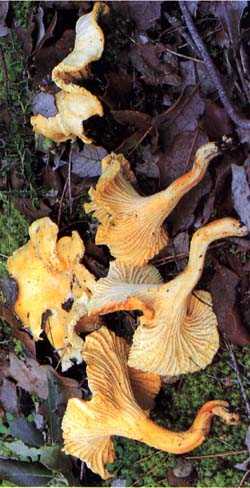
Cantharellus cibarius (Edible)
|
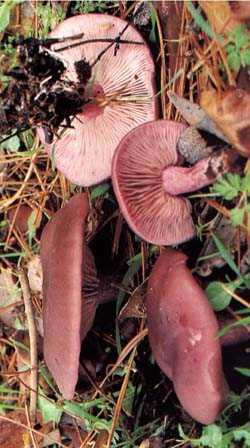
Lepista nuda (Edible)
|
| 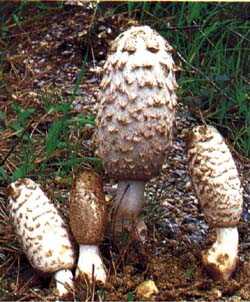
Coprinus comatus (Edible)
|
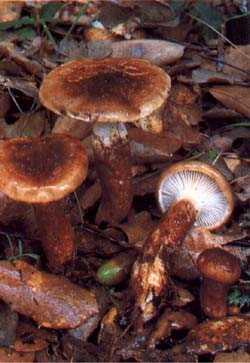
Hygrophorus personii (Edible)
|
| 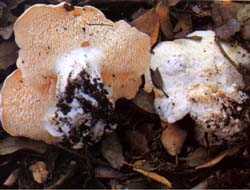
Hydnum repandum (Edible)
|
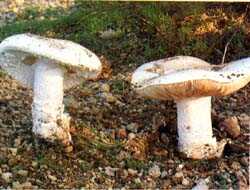
Amanita ovoidea (Edible)
|
| 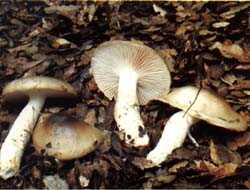
Hygrophorus latitabundus (Edible)
|
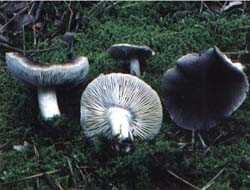
Tricholoma terreum (Edible)
|
|